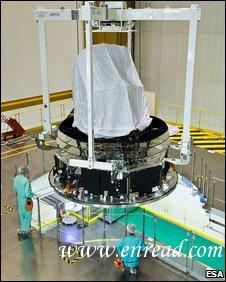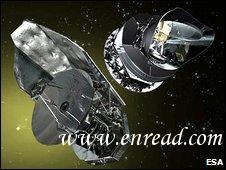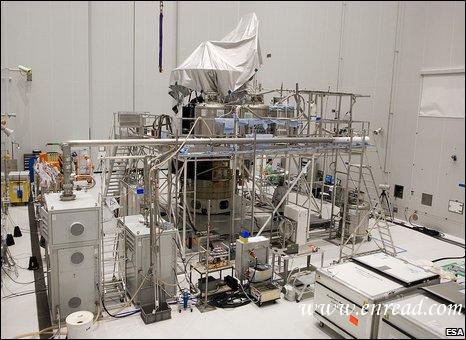| ||||||||||||||||||||||||||||||||||||||||||||||||||||||||||||||||||||||||||||||||||||||||||||||||||||||||
|
Europe's Herschel and Planck telescopes will be launched on Thursday, 14 May. 欧洲的天王星普朗克望远镜将于5月14日星期四发射。 Planck has already been installed atop the Ariane 5 launcher Officials at the Kourou spaceport in French Guiana have declared the observatories1' rocket fit to fly after some earlier technical concerns. The Ariane 5 launcher will send the telescopes out to a position some 1.5 million km from Earth on the opposite side to the Sun. This will give the astronomical2(天文的) facilities an ideal station from which to view the cosmos3. Herschel - the bigger of the two at 7.5m in height - is a far-infrared(远红外线) and sub-millimetre telescope which will investigate how stars and galaxies4 form and how they evolve. Planck will survey the Cosmic Microwave Background - a "fossil light" that pervades5 the entire Universe and is detectible(可发觉的,可看穿的) at radio wavelengths6. It should provide new insights into how the cosmos came into being, and why it looks the way it does now. "I'm extremely proud of the fact that the European Space Agency is launching two big observatories during the International Year of Astronomy," said Professor David Southwood, the director of science at the agency. "Herschel and Planck are part of the new generation of astronomical observatories. We started off close to the Earth and we've gradually moved further away; but in the future, most observatories will be in deep space, beyond the orbit of the Moon. "This allows you to control better the conditions under which the telescopes operate," he told BBC News. Herschel and Planck need to be very cold to do their science Stable stations The telescopes are being sent to the second Lagrange point (L2). It is one of five gravitational(重力的) "sweet-spots" worked out by the 18th/19th-Century French-Italian mathematician7 Joseph-Louis Lagrange. They are zones located about the Sun-Earth system where satellites can maintain station by making relatively8 few orbital corrections. Also, spacecraft stationed at L2 do not experience the swings in temperature that objects circling close to Earth sometimes undergo as they move in and out of shadow. This is particularly important for Herschel and Planck because they are "cold missions" - the science they want to do is best done with detectors9 that are chilled close to "absolute zero" (-273C; 0 kelvin). The observatories have been produced as part of a joint10 Esa programme that has taken more than 10 years to develop and which is worth some 1.9bn euros. The price makes the 14 May launch the single most valuable flight for pure science in the history of European space activity. "We will be extremely nervous until we have the rocket off the planet. You take all this very sensitive, hi-tech work - very complex - and you put it on top of a big, big firework. That's nerve-wracking," said Professor Southwood. "It's, I'm afraid, what space is all about, and we cannot make the measurements we want to make with Herschel and Planck unless we went off the planet. These are things we have to do to explore the Universe." Preparation of Herschel's helium tank continues right up to launch Helium pressure The Planck observatory11 has already been installed on top of the Ariane 5. Herschel will follow in the next few days. It will sit just above Planck inside the launcher fairing and will be first to be ejected at the end of the rocket's ascent(上升,上坡路). Herschel carries a giant tank of super-fluid helium(氦) which is used to cool its instruments. Because this helium is prone12 to(倾于) boil off, final priming of the tank needs to be done as close to launch as possible to maintain the longevity13(长寿) of the mission once in orbit. It also means that Herschel cannot tolerate a long delay once the Ariane 5 arrives at the launch pad. Mission managers say they could live with a 24-hour hold if a technical issue with the launcher arose or poor weather conditions intervened - but no longer. The Ariane would need then to return to its assembly building so engineers could again top up Herschel's helium tank. Esa officials, though, will be praying for a clean getaway. Each day's delay adds about a million euros to the cost of the Herschel-Planck programme. 点击  收听单词发音 收听单词发音
|
||||||||||||||||||||||||||||||||||||||||||||||||||||||||||||||||||||||||||||||||||||||||||||||||||||||||
- 发表评论
-
- 最新评论 进入详细评论页>>






